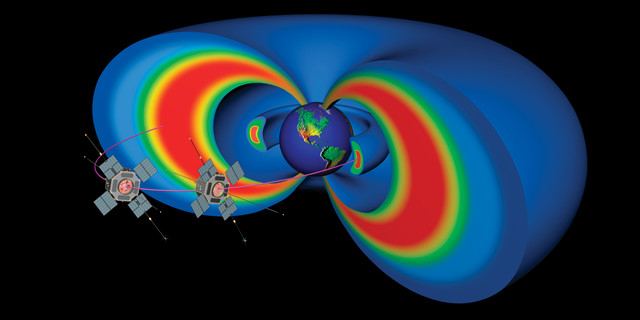
by Rachel Crowell Monday, September 10, 2018

Artist's conception of the Van Allen Probes in the radiation belts that surround Earth. Credit: Johns Hopkins University Applied Physics Laboratory.
Between about 13,500 and 58,000 kilometers above Earth’s surface, billions of high-energy particles — predominately electrons — congregate to form the outer Van Allen Belt. Nearly 4,000 kilometers closer to Earth, the outermost boundary of its twin, the second Van Allen Belt, also encircles the planet.
The powerful radiation in these belts was first recorded by NASA’s Explorer 1 after its launch in 1958, but understanding the process by which the particles become accelerated to such high energies has been a complex, decades-long puzzle. Now, using data collected during the Van Allen Probes mission that launched in 2012, researchers are unmasking the causes of so-called radiation belt enhancement events, which result in energetic particles capable of destroying satellites and other technologies. The team reported in Geophysical Research Letters that a process called local acceleration, which “takes particles located in the heart of the radiation belts and energizes [them] via interactions with electromagnetic waves,” was responsible for 87 percent of all enhancement events.
“The inner and outer doughnut-shaped Van Allen radiation belts that surround Earth pose a hazard to all spacecraft that pass through them, because the highly energized ions and electrons within the radiation belts can degrade spacecraft electronic circuits, produce logic upsets in computers, cause solar power systems to lose effectiveness and harm optical sensors, including scientific instruments,” says David Sibeck, a Van Allen Probes mission scientist at NASA’s Goddard Space Flight Center in Greenbelt, Md., who wasn’t involved with the study. Thus, he says, “understanding the nature of the radiation belts is an important task for both heliophysics researchers and spacecraft designers.”
The team, led by Alexander Boyd, a space scientist at the New Mexico Consortium, a nonprofit corporation in Los Alamos, looked at data collected from 80 enhancement events between October 2012 and April 2017. Rather than basing their conclusions on electron flux values, which can be measured directly but have some flaws, the team opted to measure phase space density, a property derived from multisatellite measurements, Boyd says. While electron flux can change when electrons move in the magnetosphere, phase space density, which is based on a system of magnetic coordinates, doesn’t, says Geoff Reeves, also a space scientist at the New Mexico Consortium and a co-author of the study.
“When looking just at flux observations, you can see times where the fluxes go up or down simply due to changes in the magnetic field moving particles around,” Boyd notes. “These changes are only temporary: When the field switches back to its original configuration, the fluxes will return to their original levels. For the purposes of this study, we were interested in times when the radiation belts undergo actual (irreversible) enhancements. When looking at phase space density in the magnetic coordinates, we get a more global picture, so any increases we see are due to these actual enhancements,” he says.
To calculate these densities, the team also incorporated data from Time History of Events and Macroscale Interactions during Substorms (THEMIS) satellites.
Local acceleration has been known to contribute to radiation belt enhancements, but had only been shown in limited studies based on single-event data collected over short periods that lasted a few days at most, Boyd says. So the researchers were surprised to find that local acceleration occurred so frequently. Many scientists expected that radial transport — which energizes particles from far away as they move into Earth’s strong magnetic field — would be the dominant acceleration process responsible for these enhancements, Boyd says. “It sort of boggles the mind that [local acceleration] should happen all the time,” he adds.
“To be sure that the electron enhancements were occurring in place, rather than coming from greater distances from Earth, [the team] needed observations from greater distances than the Van Allen Probes could reach,” Sibeck says. “Fortunately, NASA’s THEMIS spacecraft were available to provide precisely this crucial information. The study provides a good example of how observations from different sources are needed and can be pieced together to produce a clear result,” he says, adding that the study “answers one of the primary objectives of the Van Allen Probes mission in a clear, compelling and decisive manner.”
The researchers hope to apply the knowledge about the radiation belts’ evolution to one day inform space weather forecasting, Reeves says. The study is a “critical step toward future capability of predicting when, and how big, these events might be.”
However, Reeves adds, “space weather [forecasting] isn’t quite there yet.” Even with this new information, current space weather forecasts are comparable to some of the first hurricane models, he says, which “just kind of described how hurricanes work.”
© 2008-2021. All rights reserved. Any copying, redistribution or retransmission of any of the contents of this service without the expressed written permission of the American Geosciences Institute is expressly prohibited. Click here for all copyright requests.